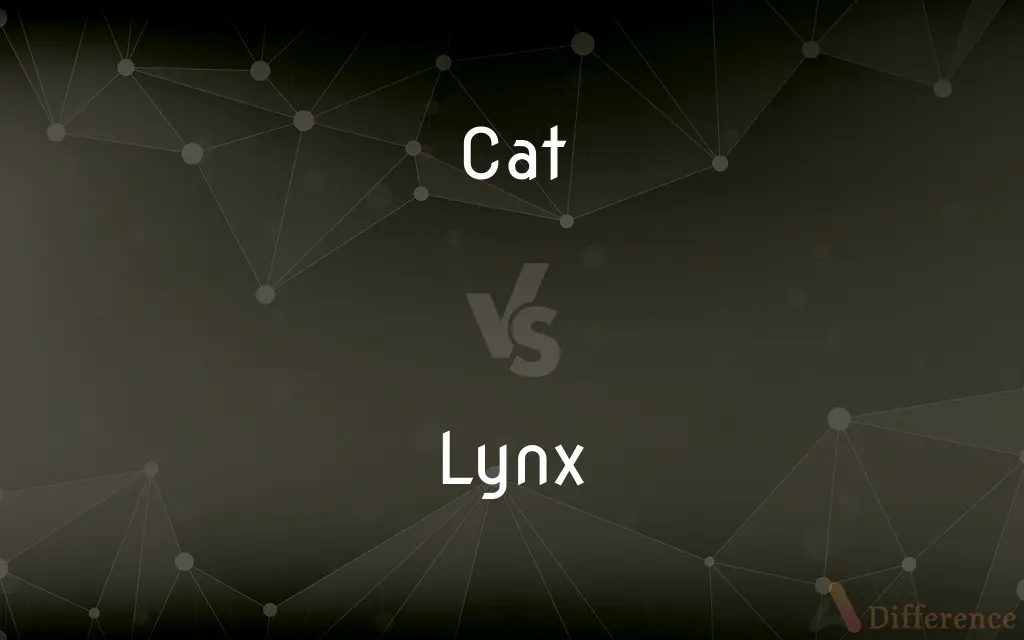Cat vs. Lynx — What's the Difference?
By Maham Liaqat & Urooj Arif — Updated on March 21, 2024
Domestic cats are small, domesticated felines, while lynxes are larger, wild cats known for their tufted ears and solitary nature.

Difference Between Cat and Lynx
Table of Contents
ADVERTISEMENT
Key Differences
Domestic cats, often simply called "cats," are small, domesticated members of the Felidae family, widely kept as pets or for catching vermin. They are known for their agility, playful behavior, and ability to form strong bonds with humans. In contrast, lynxes are medium-sized wild cats characterized by their tufted ears, short tails, and larger paws adapted for snowy environments. They are typically solitary animals, found in various forests and tundra regions across the Northern Hemisphere.
Cats have been domesticated for thousands of years and come in a wide variety of breeds, each with unique physical characteristics and temperaments. Lynxes, however, are not domesticated and are known for their elusive nature, primarily hunting at dawn or dusk for small mammals and birds. The four main species of lynx include the Eurasian lynx, Canadian lynx, Iberian lynx, and the bobcat.
While domestic cats thrive in human environments and have adapted to live in a range of conditions, from homes to farms, lynxes require large territories and wild habitats to support their solitary hunting lifestyle. The interaction of cats with humans is often characterized by mutual social behaviors, while lynxes remain distant from human settlements, avoiding contact and living a more secretive life.
The physical appearance of domestic cats can vary widely in terms of size, color, and coat pattern, depending on the breed. Lynxes, on the other hand, typically have a more uniform appearance with a base color of yellowish to reddish-brown, often with black spots and a distinctive facial ruff.
In terms of conservation, most domestic cat breeds are not at risk, although there are concerns about their impact on local wildlife as predators. Lynxes, however, face threats from habitat loss, hunting, and declining prey populations, with some species like the Iberian lynx being among the most endangered wild cats.
ADVERTISEMENT
Comparison Chart
Size
Small to medium
Larger, with longer limbs and body
Habitat
Human environments
Forests, tundra of the Northern Hemisphere
Behavior
Social with humans, varied activity patterns
Solitary, primarily dawn or dusk hunters
Physical Traits
Wide variety in coat color and pattern
Tufted ears, short tail, larger paws, typically spotted fur
Human Interaction
Domesticated, often kept as pets
Wild, avoids human contact
Conservation Status
Not at risk, but can impact local wildlife
Some species endangered, facing habitat and prey challenges
Compare with Definitions
Cat
Domesticated and adaptable.
Cats have adapted to various human environments, from apartments to farms.
Lynx
Medium-sized wild cat.
The Canadian lynx is well adapted to snowy environments with its large paws.
Cat
Wide variety of breeds.
Breeds range from the sleek Siamese to the fluffy Persian.
Lynx
Solitary and elusive.
Lynxes typically avoid human contact and live secretive lives in the wild.
Cat
Social and playful with humans.
Cats often engage in play and cuddling with their human companions.
Lynx
Characterized by tufted ears.
Lynxes are easily recognizable by the distinctive tufts of black hair on their ears.
Cat
Diverse physical characteristics.
Domestic cats display a wide range of colors, sizes, and coat patterns.
Lynx
Conservation concerns.
The Iberian lynx is critically endangered due to habitat loss and a decline in rabbit populations, its main prey.
Cat
Effective vermin hunters.
Even domestic cats retain their hunting instincts, often chasing toys or small animals.
Lynx
Specialized hunters.
Lynxes primarily prey on small mammals and birds, using stealth and agility.
Cat
The cat (Felis catus) is a domestic species of small carnivorous mammal. It is the only domesticated species in the family Felidae and is often referred to as the domestic cat to distinguish it from the wild members of the family.
Lynx
A lynx (; plural lynx or lynxes) is any of the four species (the Canada lynx, Iberian lynx, Eurasian lynx, or bobcat) within the medium-sized wild cat genus Lynx. The name lynx originated in Middle English via Latin from the Greek word λύγξ, derived from the Indo-European root leuk- ('light, brightness') in reference to the luminescence of its reflective eyes.
Cat
A small domesticated carnivorous mammal (Felis catus), kept as a pet and as catcher of vermin, and existing in a variety of breeds.
Lynx
Any of several wildcats of the genus Lynx, especially L. canadensis of northern North America or L. lynx of Eurasia, having soft thick fur, a black-tipped short tail, and tufted ears.
Cat
Any of various other carnivorous mammals of the family Felidae, including the lion, tiger, leopard, and lynx.
Lynx
Lynx A constellation in the Northern Hemisphere, near Auriga and Gemini.
Cat
(Informal) A woman who is regarded as spiteful.
Lynx
Any of several medium-sized wild cats, mostly of the genus Lynx.
Cat
A person, especially a man.
Lynx
Any one of several species of feline animals of the genus Felis, and subgenus Lynx. They have a short tail, and usually a pencil of hair on the tip of the ears.
Cat
A player or devotee of jazz music.
Lynx
One of the northern constellations.
Cat
A cat-o'-nine-tails.
Lynx
Short-tailed wildcats with usually tufted ears; valued for their fur
Cat
A catfish.
Cat
A cathead.
Cat
A device for raising an anchor to the cathead.
Cat
A catboat.
Cat
A catamaran.
Cat
To hoist an anchor to (the cathead).
Cat
An animal of the family Felidae:
Cat
A domesticated species (Felis catus) of feline animal, commonly kept as a house pet.
Cat
Any similar animal of the family Felidae, which includes lions, tigers, bobcats, leopards, cougars, cheetahs, caracals, lynxes, and other such non-domesticated species.
Cat
A person:
Cat
(offensive) A spiteful or angry woman.
Cat
An enthusiast or player of jazz.
Cat
(slang) A person (usually male).
Cat
(slang) A prostitute.
Cat
(nautical) A strong tackle used to hoist an anchor to the cathead of a ship.
Cat
Short form of cat-o'-nine-tails.
Cat
(archaic) A sturdy merchant sailing vessel now only in "catboat".
Cat
The game of "trap and ball" (also called "cat and dog").
Cat
The trap of the game of "trap and ball".
Cat
(archaic) The pointed piece of wood that is struck in the game of tipcat.
Cat
A vagina, a vulva; the female external genitalia.
Cat
A double tripod (for holding a plate, etc.) with six feet, of which three rest on the ground, in whatever position it is placed.
Cat
(historical) A wheeled shelter, used in the Middle Ages as a siege weapon to allow assailants to approach enemy defences.
Cat
(computing) A program and command in Unix that reads one or more files and directs their content to the standard output.
Cat
(slang) A street name of the drug methcathinone.
Cat
Abbreviation of catapult
A carrier's bow cats
Cat
Abbreviation of catalytic converter
Cat
Abbreviation of catamaran
Cat
Abbreviation of category
Cat
Abbreviation of catfish
Cat
Abbreviation of caterpillar
Cat
(slang) Any of a variety of earth-moving machines. (from their manufacturer Caterpillar Inc.)
Cat
A ground vehicle which uses caterpillar tracks, especially tractors, trucks, minibuses, and snow groomers.
Cat
Abbreviation of computed axial tomographyOften used attributively, as in “CAT scan” or “CT scan”.
Cat
To hoist (the anchor) by its ring so that it hangs at the cathead.
Cat
To flog with a cat-o'-nine-tails.
Cat
(slang) To vomit.
Cat
To go wandering at night.
Cat
To gossip in a catty manner.
Cat
To apply the cat command to (one or more files).
Cat
To dump large amounts of data on (an unprepared target), usually with no intention of browsing it carefully.
Cat
Catastrophic; terrible, disastrous.
The weather was cat, so they returned home early.
Cat
Any animal belonging to the natural family Felidae, and in particular to the various species of the genera Felis, Panthera, and Lynx. The domestic cat is Felis domestica. The European wild cat (Felis catus) is much larger than the domestic cat. In the United States the name wild cat is commonly applied to the bay lynx (Lynx rufus). The larger felines, such as the lion, tiger, leopard, and cougar, are often referred to as cats, and sometimes as big cats. See Wild cat, and Tiger cat.
Laying aside their often rancorous debate over how best to preserve the Florida panther, state and federal wildlife officials, environmentalists, and independent scientists endorsed the proposal, and in 1995 the eight cats [female Texas cougars] were brought from Texas and released. . . . Uprooted from the arid hills of West Texas, three of the imports have died, but the remaining five adapted to swamp life and have each given birth to at least one litter of kittens.
Cat
A strong vessel with a narrow stern, projecting quarters, and deep waist. It is employed in the coal and timber trade.
Cat
A double tripod (for holding a plate, etc.), having six feet, of which three rest on the ground, in whatever position it is placed.
Cat
An old game;
Cat
Same as cat o' nine tails; as, British sailors feared the cat.
Cat
A catamaran.
Cat
To bring to the cathead; as, to cat an anchor. See Anchor.
Cat
Feline mammal usually having thick soft fur and being unable to roar; domestic cats; wildcats
Cat
An informal term for a youth or man;
A nice guy
The guy's only doing it for some doll
Cat
A spiteful woman gossip;
What a cat she is!
Cat
A whip with nine knotted cords;
British sailors feared the cat
Cat
A large vehicle that is driven by caterpillar tracks; frequently used for moving earth in construction and farm work
Cat
Any of several large cats typically able to roar and living in the wild
Cat
A method of examining body organs by scanning them with X rays and using a computer to construct a series of cross-sectional scans along a single axis
Cat
Beat with a cat-o'-nine-tails
Cat
Eject the contents of the stomach through the mouth;
After drinking too much, the students vomited
He purged continuously
The patient regurgitated the food we gave him last night
Common Curiosities
Are lynxes dangerous to humans?
Lynxes are generally not dangerous to humans due to their elusive nature and preference for avoiding contact. However, like any wild animal, they can be unpredictable if cornered or threatened.
How do domestic cats impact the environment?
Domestic cats can significantly impact local wildlife, especially bird populations, due to their hunting instincts, even when well-fed.
Can domestic cats and lynxes interbreed?
While domestic cats and lynxes are both felids, they are different species with significant genetic differences, making interbreeding highly unlikely.
Do domestic cats have any wild cat relatives?
Yes, domestic cats are believed to have been domesticated from the African wildcat, sharing many behavioral and physical traits.
How do lynxes adapt to their environments?
Lynxes adapt through their physical traits, such as large paws for moving through snow, and their solitary, stealthy hunting behaviors suited to their specific habitats.
How do lynxes communicate?
Lynxes communicate through vocalizations, scent marking, and body language, similar to other felines, but are generally more silent due to their solitary nature.
What distinguishes a domestic cat from a lynx?
The main differences include size, habitat, behavior, and physical traits, with domestic cats being smaller, more sociable with humans, and adaptable to various environments, while lynxes are larger, solitary, and adapted to wild habitats.
How can you tell a lynx apart from other wild cats?
Lynxes can be distinguished by their tufted ears, short tails, larger paws adapted for snowy environments, and often spotted fur.
Can lynxes be found in urban areas?
While rare, lynxes can sometimes be spotted in urban fringes or areas close to forests, but they generally avoid human settlements.
Are all lynxes the same size?
No, the size of lynxes can vary among species, with the Eurasian lynx being the largest and the bobcat generally the smallest.
What conservation efforts are in place for lynxes?
Conservation efforts for lynxes include habitat protection, anti-poaching measures, and, in some cases, breeding programs to reintroduce lynxes to areas where they have become extinct.
Why do lynxes have tufted ears?
The tufts on a lynx's ears are thought to enhance their hearing by funneling sounds into the ears, aiding in their hunting abilities.
What role do domestic cats play in human history?
Domestic cats have played numerous roles, from being worshipped in ancient Egypt to controlling vermin populations in agricultural societies, and now as companions.
What is the average lifespan of a domestic cat compared to a lynx?
Domestic cats can live 15 years or more with proper care, while lynxes in the wild have shorter lifespans, typically around 10-15 years.
Are there any health benefits to owning a domestic cat?
Yes, owning a cat can reduce stress and anxiety, lower blood pressure, and provide companionship, enhancing overall mental health.
Share Your Discovery

Previous Comparison
Look vs. Stare
Next Comparison
Evolve vs. DevelopAuthor Spotlight
Written by
Maham LiaqatCo-written by
Urooj ArifUrooj is a skilled content writer at Ask Difference, known for her exceptional ability to simplify complex topics into engaging and informative content. With a passion for research and a flair for clear, concise writing, she consistently delivers articles that resonate with our diverse audience.
















































